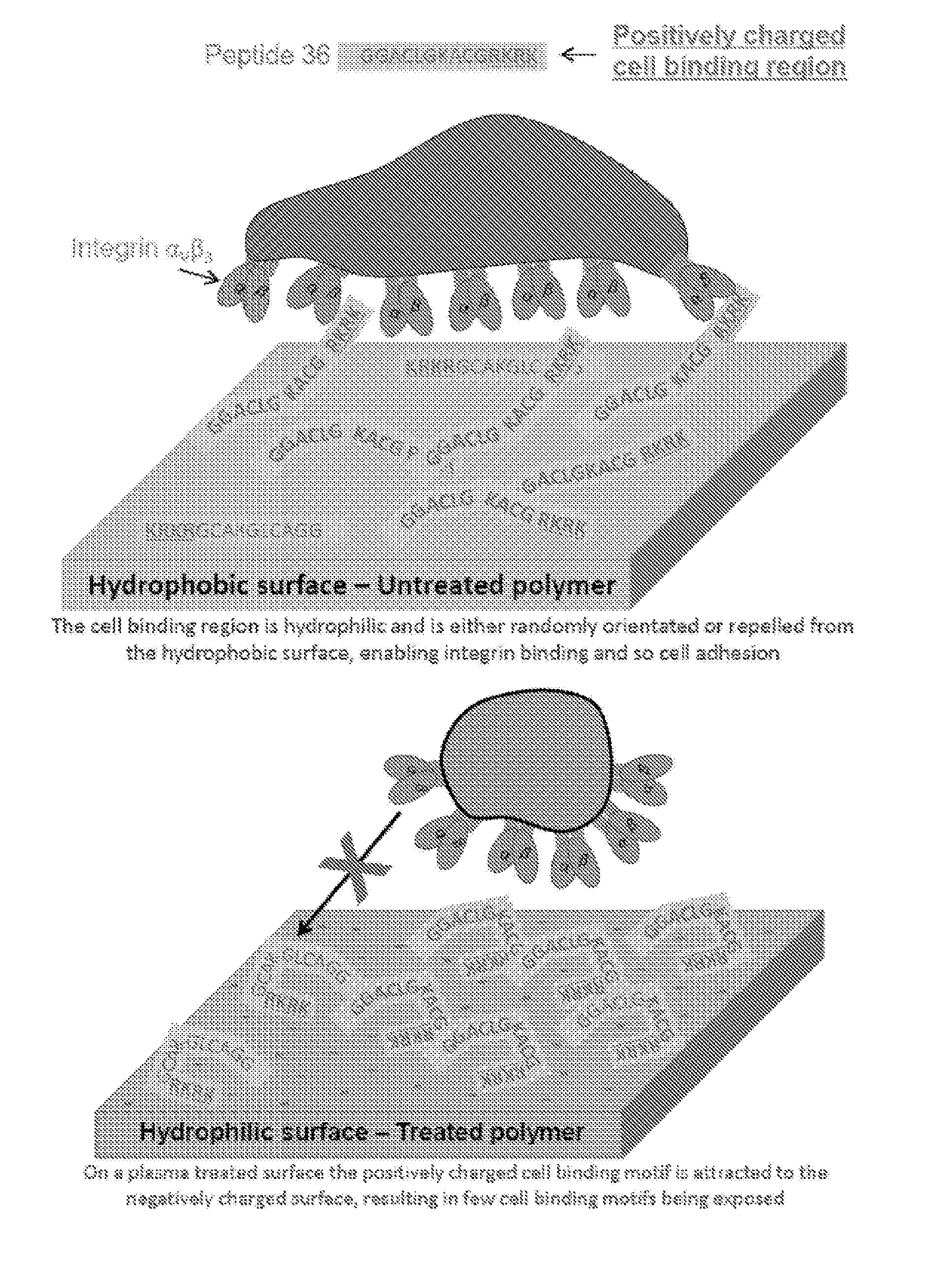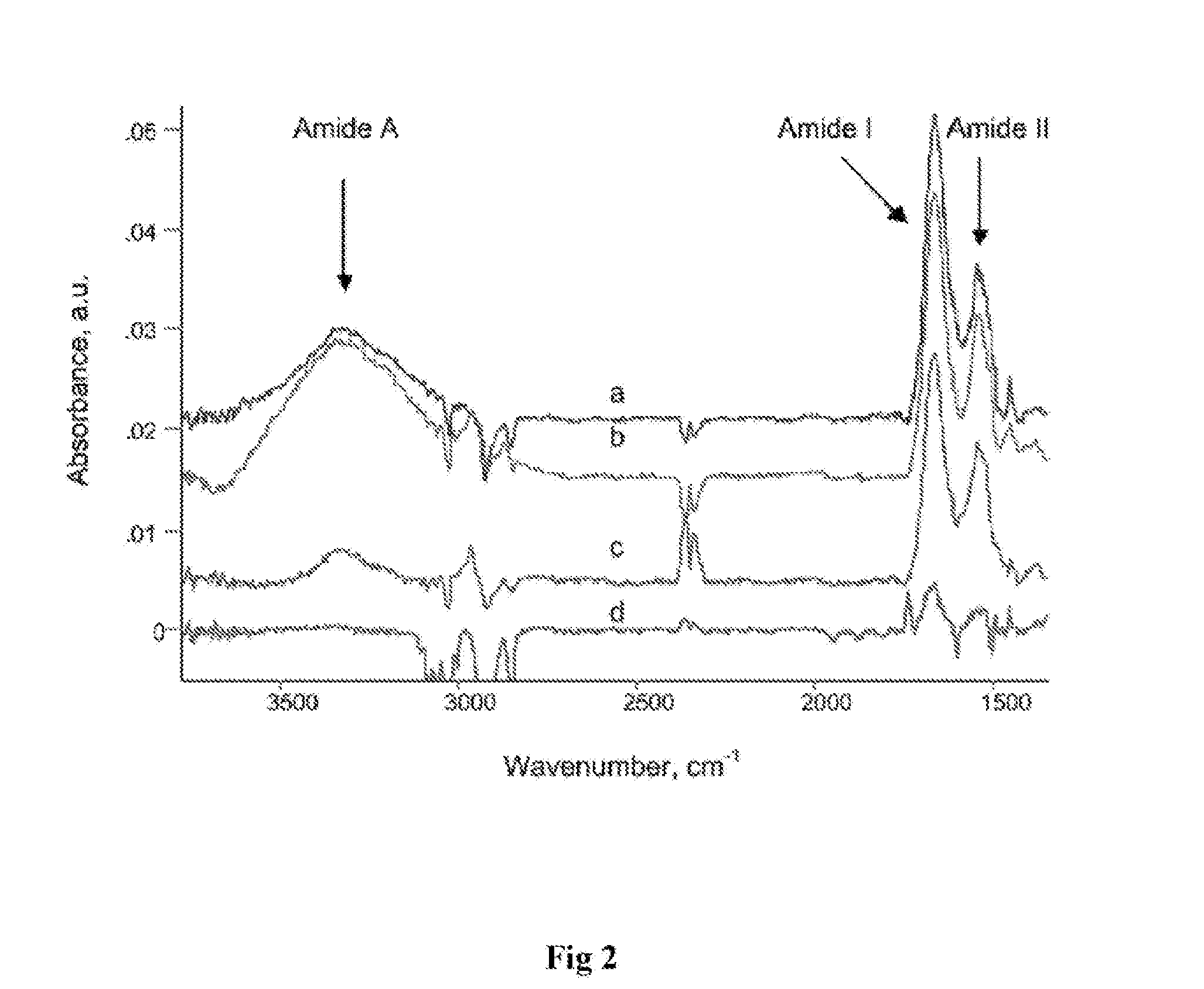Materials and methods
- Summary
- Abstract
- Description
- Claims
- Application Information
AI Technical Summary
Benefits of technology
Problems solved by technology
Method used
Image
Examples
example 1
Peptide 36 Interactions with PIII Treated Polystyrene
[0088]We have previously detailed the surface induced modulation of tropoelastin-cell binding by PIII treatment of PTFE [5, 6]. This activity modulation was attributed to differential exposure of the C-terminus of tropoelastin. Previously using a biochemical approach we have identified peptide 36 (ACLGKACGRKRK) from exon 36 (FIG. 1A) as a major cell binding motif that is present at the C-terminus of tropoelastin [7]. We therefore tested if peptide 36, in isolation from the remainder of the tropoelastin molecule could support cell binding on untreated and PIII treated polystyrene (FIG. 1B). When coated onto PIII treated polystyrene peptide 36 did not support cell binding above BSA background controls with maximal 5.1±0.5% cell attachment using a coating concentration of 50 μM. In contrast peptide 36 supported cell attachment in a dose dependent manner on untreated polystyrene. Maximal 98.6±12.5% peptide 36-dependent cell attachment...
example 2
Surface Modulation of RKRK Dependent Cell Binding to Peptide 36
[0090]Cell binding assays were used to further probe the cell binding activity of peptide 36 on untreated versus PIII treated polystyrene (FIG. 3). Although PIII treated polystyrene supports high levels of cell attachment in the absence of protein coating, peptide 36 is not cell adhesive on this surface (FIG. 3A). In contrast untreated polystyrene possesses low levels of cell binding in the absence of protein coating. However upon peptide 36 coating untreated polystyrene supports high levels of cell adhesion. Consistent with peptide 36 removal from untreated polystyrene, tween-20 washing reduced peptide 36 dependent binding on untreated polystyrene to background levels. Furthermore ΔRKRK peptide 36 did not support cell binding on either surface (FIG. 3B). Therefore the C-terminal RKRK motif is critical for peptide 36-cell binding on these surfaces. Peptide 36-dependent cell spreading showed a similar profile where cells ...
example 3
Surface Charge Modulation of Peptide 36-Directed Cell Attachment
[0092]PIII treatment breaks bonds in polymers resulting in the formation of high energy radicals. When exposed to air these radicals can react with atmospheric oxygen, forming oxidized chemical groups such as ester, carbonyl and carboxyl groups. This results in increased polarity of the surface with a net negative charge [9, 10]. Peptide 36 has a strongly positively charged region encompassed by the RKRK C-terminal cell binding site. Therefore we proposed that electrostatic interactions with the negatively charged PIII treated surface are orientating peptide 36, thereby sterically hindering cell engagement with the peptide (FIG. 3D). To determine if such negatively charged COOH groups could be responsible for peptide 36 activity modulation we measured surface COOH groups using toluidine blue O on plasma treated PTFE (FIG. 5A). Plasma was used in preference to PIII treatment so that a gradual increase in fluence could be...
PUM
| Property | Measurement | Unit |
|---|---|---|
| Fraction | aaaaa | aaaaa |
| Length | aaaaa | aaaaa |
| Concentration | aaaaa | aaaaa |
Abstract
Description
Claims
Application Information
 Login to View More
Login to View More - R&D
- Intellectual Property
- Life Sciences
- Materials
- Tech Scout
- Unparalleled Data Quality
- Higher Quality Content
- 60% Fewer Hallucinations
Browse by: Latest US Patents, China's latest patents, Technical Efficacy Thesaurus, Application Domain, Technology Topic, Popular Technical Reports.
© 2025 PatSnap. All rights reserved.Legal|Privacy policy|Modern Slavery Act Transparency Statement|Sitemap|About US| Contact US: help@patsnap.com



